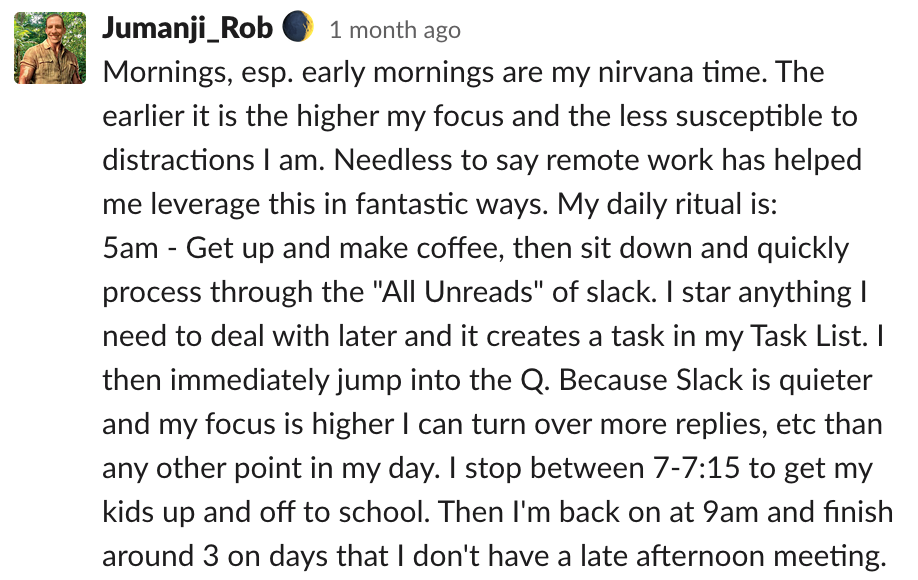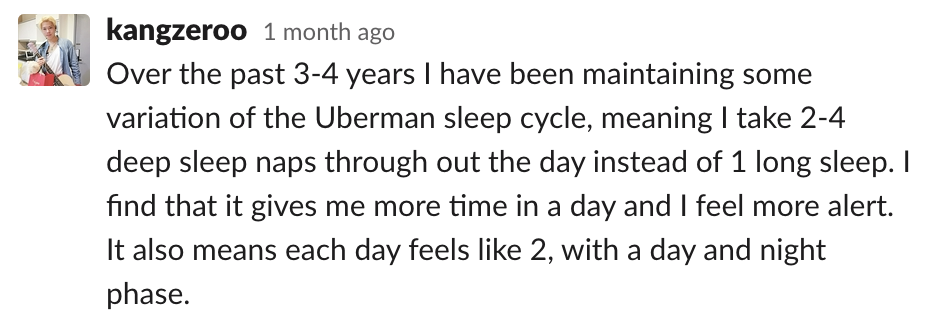Right now, working from home means adhering to a ridiculously strict schedule. Wake up early enough to get to the grocery store before it's mobbed, be ready to help your kids sign on to their Zoom classes, feed your family—and, you know, get some work done.
But that's not what remote work is typically like. Usually, working from home is all about flexibility. Zapier is a 100 percent distributed company, and we have over 800 employees all over the world. Every single one of us has a different schedule.
And we're not talking just about starting an hour early in order to go to a doctor's appointment or taking a break mid-day to do our laundry—though we do that too. We have all sorts of unusual schedules on our team, and it makes us more productive. Here are a few examples.
Early risers and night owls
Zapier senior editor Grace Montgomery has a seven-year-old son, and she's structured her remote work day around getting him ready for school and being there when he's done. She wakes up early and works a two-hour shift from 5 a.m. – 7 a.m. Then, she gets her kid out of bed and to school, then starts work again at 8:30 a.m. Her day is over at 2:30 p.m., and she can spend the rest of the afternoon with her son.
Senior Customer Champion Rob Hubbard is another early riser, both for kid reasons and productivity reasons: "The earlier it is, the higher my focus and the less susceptible to distractions I am. Needless to say remote work has helped me leverage this in fantastic ways."

Then there's the other end of the spectrum. Senior Engineer David Brownman sleeps in and usually starts work around 10 a.m. He stops around 3:30 p.m. for gym, shower, relaxing, and hanging with his significant other. When she goes to bed around 10 p.m., he digs back in: "I've got a couple more (very quiet and focus-heavy) hours between 10 p.m. and 1 a.m. to work."
It's not always a matter of early versus late—some people, like Senior Research Operations Program Manager Roy Olende, work longer hours on some days to give themselves a break on other days. Roy says: "On Thursdays I tend to work a little longer so that Fridays feel much more relaxed. I sometimes sign off from work by 2 p.m. on Friday."
Remote work allows you to work when it fits your lifestyle and you're most productive. One way to figure out when it's best for you to work is to find your chronotype and schedule your productivity around it.
Batching for productivity
Batching is a common productivity strategy: group like tasks together so your brain doesn't have to do too much context-switching. But you can also batch your work as a whole. This is something Zapier Product Designer Tabitha Karcher recently started doing:
I find it difficult to focus on anything for more than 3 – 5 hours at a time. Because of this, I often tend to sit at my work desk for 10 – 12 hours straight, frustrated because I've only done a few hours worth of work, and force myself to stay until my work is "done," which isn't really working out for my mental health or my work quality or speed.
If you work in an office, it's hard to address this kind of issue. But as a remote worker, you have control of your day. Tabitha's solution is to do three- to four-hour work sessions with two- to three-hour breaks in between. That way, she can focus on specific tasks during each session. "My brain will know that I have a break to do other things coming up in a specific amount of time if I need it," she says. It's kind of like an exaggerated Pomodoro Technique.
One of our Zapier engineers, who goes by @kangzeroo on Slack, does something similar. But instead of breaks, he takes naps:

Kangzeroo starts his day around 10 p.m. or midnight in Taiwan. Most of his team operates on North American hours, so he's online when they are, but he also finds that night time is better for producing code. He admits it's not great for his social life, but he makes it work.
One-off weird schedules
Of course, not everyone follows unusual schedules all the time. Plenty of us, myself included, usually work a standard 9 to 5. But the benefit of working from home is that, if you need to—or just want to—you can adjust your schedule on any given day.
A quick search for "weird schedule" in the Zapier Slack surfaces all sorts of examples.



We try not to have different schedules every day—otherwise it gets hard for our teammates to know when they'll be able to get a hold of us. But even if you tend to work pretty regular hours, as a remote worker, you're likely to change it up every so often.
Keeping up with changing schedules
Zapier Engineer Stacie Taylor-Cima notes that, with all this flexibility comes the responsibility to keep your Slack status and calendars up to date. That way, coworkers know if you're available or when you'll be available.
You can automatically set your Slack status, so it will change depending on whatever trigger you choose, like a Google Calendar event or a recurring personal scheduling conflict. You can even set your status off the cuff with Google Assistant or Alexa.
Update Slack status during new Google Calendar events
Set Slack statuses with Google Assistant voice commands
As long as your changing schedule doesn't take a toll on you or your coworkers' productivity, it's a great way to foster a healthy work-life balance. Stacie sums it up nicely:
Having this flexi schedule has given me a lot more empathy for the unique lives we all live and schedules we follow. Everyone is different and thrives differently, and having a flexi/remote career is a brilliant way to help all of us find optimal productivity while living the lives we want and maintaining all the other aspects of our lives that make us who we are.





